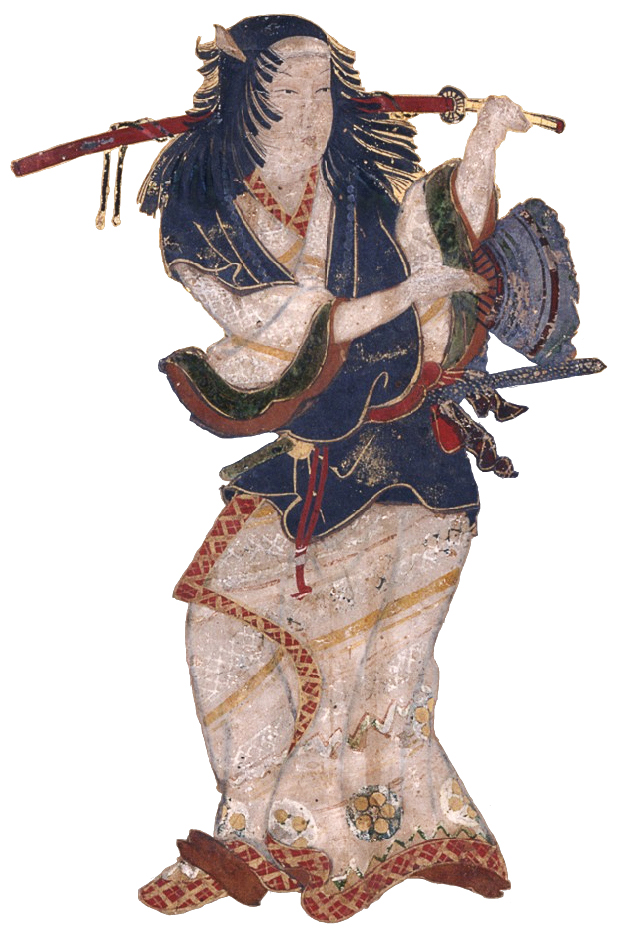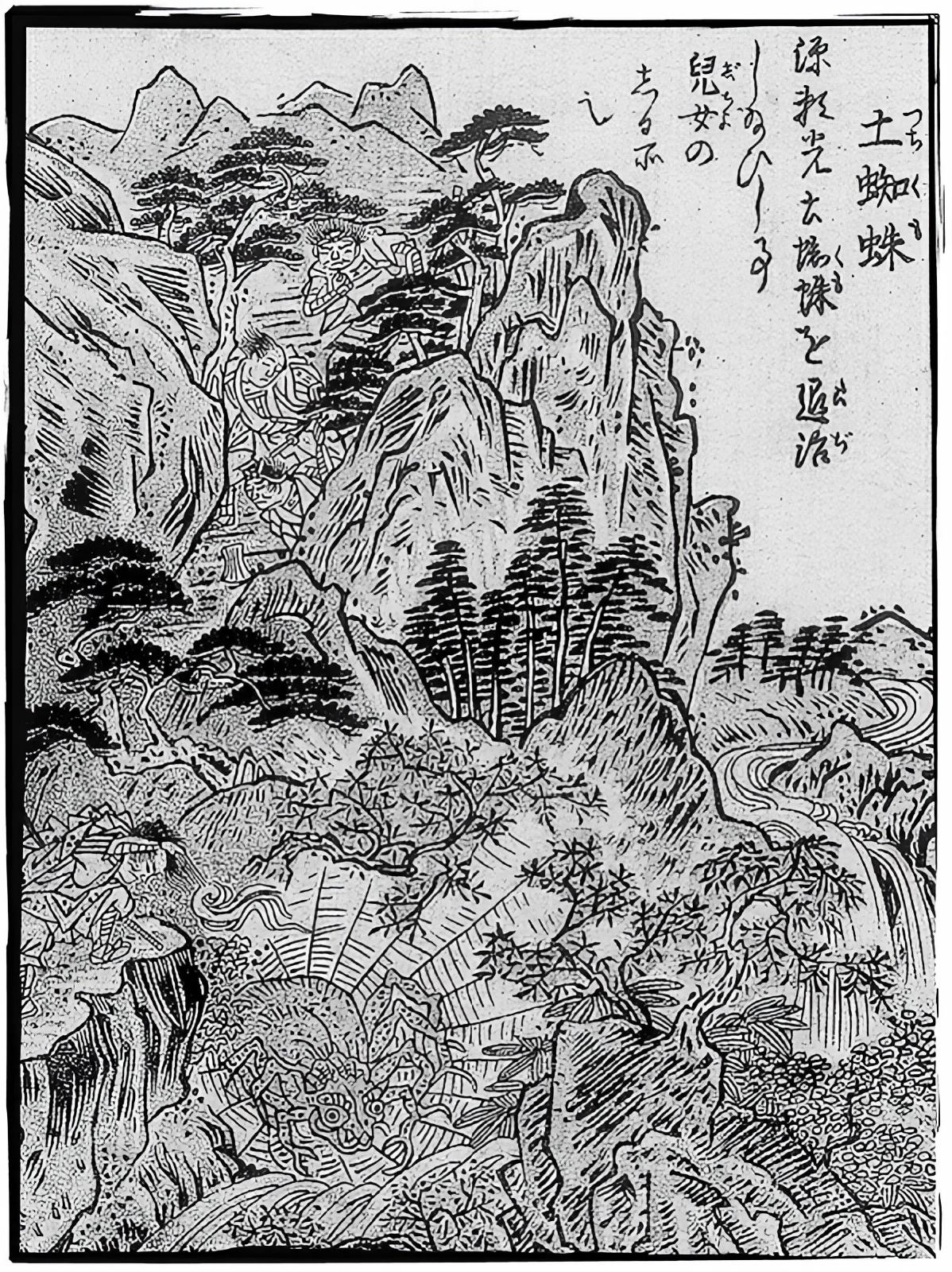|
Kumadori
is the stage makeup worn by kabuki actors, mostly when performing kabuki plays in the style. The term also applies to a painting method in which two brushes are used simultaneously, one for the color and the other used to create shading or other details. makeup generally consists of brightly coloured stripes or patterns over a Oshiroi, white foundation, the colours and patterns symbolising aspects of the character. Though was originated and developed extensively by members of the family of actors, some conventions are creations of the line. Colours Only a few colours are used in makeup; red, blue, brown and black. Whilst black is simply used to exaggerate features, such as eyebrows and the line of the mouth, the other colours are used to tell the audience about the character's nature. Red indicates a powerful hero role, often a character with virtue and courage. The most famous role to use red is that of the hero in , , and has come to stereotypically represent ka ... [...More Info...] [...Related Items...] OR: [Wikipedia] [Google] [Baidu] |
Kabuki
is a classical form of Theatre of Japan, Japanese theatre, mixing dramatic performance with Japanese traditional dance, traditional dance. Kabuki theatre is known for its heavily stylised performances, its glamorous, highly decorated costumes, and for the elaborate make-up worn by some of its performers. Kabuki is thought to have originated in the early Edo period, when the art's founder, Izumo no Okuni, formed a female dance troupe that performed dances and light sketches in Kyoto. The art form later developed into its present all-male theatrical form after women were banned from performing in kabuki theatre in 1629. Kabuki developed throughout the late 17th century and reached its zenith in the mid-18th century. In 2005, kabuki theatre was proclaimed by UNESCO as an intangible heritage possessing outstanding universal value. In 2008, it was inscribed in the UNESCO Intangible Cultural Heritage Lists, UNESCO Representative List of the Intangible Cultural Heritage of Humanity ... [...More Info...] [...Related Items...] OR: [Wikipedia] [Google] [Baidu] |
Aragoto
, or 'rough style', is a style of kabuki acting that uses exaggerated, dynamic (forms or movements) and speech. roles are characterised by the bold red or blue makeup () worn by actors, as well as their enlarged and padded costumes. The term is an abbreviation of the term , which literally means "wild-warrior style". The style was created and pioneered by Ichikawa Danjūrō I, a kabuki actor in the Edo period (1603-1867), and has come to be epitomized by his successors in the Ichikawa Danjūrō line of kabuki actors. Roles such as the leads in and are particularly representative of the style. is often contrasted with the ("soft" or "gentle") style, which emerged around the same time but focuses on more naturalistic drama. It is also contrasted with or "female-like style". Notable Aragotoshi * The Bandō Mitsugorō line ** Bandō Mitsugorō VIII ** Bandō Mitsugorō X Bandō Mitsugorō X () (January 23, 1956 – February 2, 2015) was a Japanese television presente ... [...More Info...] [...Related Items...] OR: [Wikipedia] [Google] [Baidu] |
Oshiguma
An is an impression of the (face make-up) of kabuki actors on a piece of cloth, usually silk or cotton, created as an artwork and memento. are customarily made after the performance of a kabuki play, though not necessarily after every performance, and given as highly valued souvenirs of the event. A single may have face-impressions from one or several actors, usually all from the same show, illustrating the make-up designs for major characters in the play Play most commonly refers to: * Play (activity), an activity done for enjoyment * Play (theatre), a work of drama Play may refer also to: Computers and technology * Google Play, a digital content service * Play Framework, a Java framework * P .... It may also include autographs, dates and additional inscriptions; sometimes other graphic elements are added to the design. The same term can also be used to describe an artistic depiction of kabuki make-up created by other means, but intended to emulate the appearance ... [...More Info...] [...Related Items...] OR: [Wikipedia] [Google] [Baidu] |
Cultural History Of Japan
Japanese culture has changed greatly over the millennia, from the country's prehistoric Jōmon period, to its contemporary modern culture, which absorbs influences from Asia and other regions of the world. Since the Jomon period, ancestral groups like the Yayoi period, Yayoi and Kofun period, Kofun, who arrived to Japan from Korea and China, respectively, have shaped Japanese culture. Rice cultivation and centralized leadership were introduced by these groups, shaping Japanese culture. Chinese dynasties, particularly the Tang dynasty, have influenced Japanese culture throughout history and brought it into the Sinosphere. After 220 years of isolation, the Meiji era opened Japan to Western influences, enriching and diversifying Japanese culture. Japanese popular culture, Popular culture shows how much contemporary Japanese culture influences the world. Identity There are two competing hypotheses that try to explain the lineage of the Japanese people. The first hypothesis p ... [...More Info...] [...Related Items...] OR: [Wikipedia] [Google] [Baidu] |
Shibaraku
is a play in the Kabuki repertoire, and one of the celebrated '' Kabuki Jūhachiban'' ("Eighteen Great Plays"). The play is noted for its flamboyantly dramatic costumes and makeup (''kumadori'').{{citation needed, date=May 2017 Originally staged by Ichikawa Danjūrō I in 1697 at the Nakamura-za, it was very popular, and quickly began to be included at the annual '' kaomise'' celebrations of each theatre in Edo. For a time, the main role was frequently different, depending on the whims of the theatre and the troupe. The piece was standardized somewhat in the early 19th century by Danjūrō VII, and reworked again by Danjūrō IX at the end of that century. This version has been performed since then. A scene of roughly 50 minutes, ''Shibaraku'' is not a play unto itself, but a short drama inserted during interludes or in between full plays to provide variety and maintain a certain level of energy and interest on the part of the audience. Today it is played mostly on special ... [...More Info...] [...Related Items...] OR: [Wikipedia] [Google] [Baidu] |
Tsuchigumo
is a historical Japanese derogatory term for renegade local clans, primarily during the Asuka, Nara, and early Heian periods, and also the name for a race of spider-like in Japanese folklore. Alternative names for the historical groups include ,瀧音能之, Takioto Yoshiyuki, in 松枝到, Matsueda Itaru (ed.)「土蜘蛛の原義について」(On the original meaning of Tsuchigumo)『象徴図像研究:動物と象徴』(Symbolic Iconography Research: Animals and Symbols) 言叢社 (Gensōsha), 2006 ISBN 4-86209-007-9 pp.79-100. and for the mythological ''Tsuchigumo'', and . In the ''Kojiki'' and ''Nihon Shoki'', the name was phonetically spelled with the four kanji (for the four morae ''tsu-chi-gu-mo''). References to "tsuchigumo" appear in the chronicles associated with Emperor Jimmu, Emperor Keiko, and Empress Jingū, and these words were frequently used in the (ancient reports on provincial culture, geography, and oral tradition) of various provinces, including Mutsu P ... [...More Info...] [...Related Items...] OR: [Wikipedia] [Google] [Baidu] |
Makeup
Cosmetics are substances that are intended for application to the body for cleansing, beautifying, promoting attractiveness, or altering appearance. They are mixtures of chemical compounds derived from either natural sources or created synthetically. Cosmetics have various purposes, including personal and skin care. They can also be used to conceal blemishes and enhance natural features (such as the eyebrows and eyelashes). Makeup can also add colour to a person's face, enhance a person's features or change the appearance of the face entirely to resemble a different person, creature, or object. People have used cosmetics for thousands of years for skin care and appearance enhancement. Visible cosmetics for both women and men have gone in and out of fashion over the centuries. Some early forms of cosmetics contained harmful ingredients such as lead that caused serious health problems and sometimes resulted in death. Modern commercial cosmetics are generally tested for ... [...More Info...] [...Related Items...] OR: [Wikipedia] [Google] [Baidu] |
Costume Design
Costume design is the process of selecting or creating clothing for a performers. A costume may be designed from scratch or may be designed by combining existing garments. "Costume" may also refer to the style of dress particular to a nation, a social class, or historical period. It is intended to contribute to the fullness of the artistic, visual world which is unique to a particular theatrical or cinematic production. Costumes can denote status, age, or personality of a character, or provide visual interest to a character. Costumes may be for a theater, film, cinema, musical performance, cosplay, parties, or other events. History In ancient Greek theatre, costumes were simplistic yet symbolic, aiding in character differentiation. Ritualized masks were a defining feature, allowing actors to convey emotions without switching masks. Ancient Greek village festivals and processions in honor of Dionysus (See also: Dionysia) are believed to be the origin of theatre, and therefore the ... [...More Info...] [...Related Items...] OR: [Wikipedia] [Google] [Baidu] |
Tsuchigumo Soushi
is a historical Japanese derogatory term for renegade local clans, primarily during the Asuka, Nara, and early Heian periods, and also the name for a race of spider-like in Japanese folklore. Alternative names for the historical groups include , Takioto Yoshiyuki, in Matsueda Itaru (ed.)「土蜘蛛の原義について」(On the original meaning of Tsuchigumo)『象徴図像研究:動物と象徴』(Symbolic Iconography Research: Animals and Symbols) 言叢社 (Gensōsha), 2006 ISBN 4-86209-007-9 pp.79-100. and for the mythological ''Tsuchigumo'', and . In the ''Kojiki'' and ''Nihon Shoki'', the name was phonetically spelled with the four kanji (for the four morae ''tsu-chi-gu-mo''). References to "tsuchigumo" appear in the chronicles associated with Emperor Jimmu, Emperor Keiko, and Empress Jingū, and these words were frequently used in the (ancient reports on provincial culture, geography, and oral tradition) of various provinces, including Mutsu, Echigo, Hitachi, Se ... [...More Info...] [...Related Items...] OR: [Wikipedia] [Google] [Baidu] |
Minamoto No Raikō
, also known as Minamoto no Raikō, was a Japanese samurai of the Heian period, who served the regents of the Fujiwara clan along with his brother Yorinobu, taking the violent measures the Fujiwara were themselves unable to take. He is one of the earliest Minamoto of historical note for his military exploits, and is known for quelling the bandits of Ōeyama. His loyal service earned him the governorships of Izu Province, Kozuke and a number of others in turn, as well as a number of other high government positions. Yorimitsu served as commander of a regiment of the Imperial Guard, and as a secretary in the Ministry of War. When his father Minamoto no Mitsunaka died, he inherited Settsu Province. Yorimitsu is usually accompanied by his four legendary retainers, known as the Shitennō (The Four Heavenly Kings). They were Watanabe no Tsuna, Sakata no Kintoki, Urabe no Suetake, and Usui Sadamitsu. Legends Yorimitsu is featured in a number of legends and tales, including th ... [...More Info...] [...Related Items...] OR: [Wikipedia] [Google] [Baidu] |
:Category:Japanese Words And Phrases ...
{{Commons Words and phrases by language Words Words Words A word is a basic element of language that carries meaning, can be used on its own, and is uninterruptible. Despite the fact that language speakers often have an intuitive grasp of what a word is, there is no consensus among linguists on its ... [...More Info...] [...Related Items...] OR: [Wikipedia] [Google] [Baidu] |




